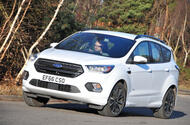This post was originally published on Autocar

The second-generation Ford Kuga is a sweet-handling family car that is refined and comfortable – but is this athletic SUV a good used buy?
The second-generation Ford Kuga isn’t just a versatile, smart-looking and sensible SUV. No, another reason this became one of Ford’s best-selling models is because it’s a surprisingly rewarding car to drive – even matching some of its premium-badged SUV rivals for refinement and dynamism.You won’t pay a premium price, though. Just £2000 is all you need to snap up a Mk2 Kuga these days – if you can stomach the signs of heavy use and high miles of cars at this price point – but even more recent, better-kept examples can still be had for four figures, so let’s get familiar with this family hauler.The wheelbase is the same as the Mk1’s, but with an extra 81mm added to its length and some clever packaging tricks, the Kuga is more capacious in the front and rear.There are generous helpings of head and leg room so adults will feel comfortable in the back. Boot space is far better than its predecessor’s too, at 800 litres with the rear seats up, which means there’s plenty of room for pets, suitcases, the weekly shop and family paraphernalia.Perceived quality inside is good and certainly lives up to the high standards that Ford set itself in the mid-2010s. Sure, there are some scratchy plastics here and there, but it’s enhanced by some chrome-esque finishes that bolster its upmarket credentials.Of course, the calibre of finish in the cabin varies according to trim level, and while the entry-level Zetec has alloys, a digital radio and air-con, the slightly swisher Titanium (which has larger wheels, climate control, parking sensors and partial leather trim) is the sweet spot – and only marginally more expensive.Ford’s early Microsoft Sync infotainment system is straightforward but it does feel pretty dated nowadays, so if you’re after more modern tech, you’ll want the facelifted car, which arrived in 2016.It received the usual styling tweaks and a new engine line-up but, more importantly, inside it gained a new Sync 3 infotainment system with an 8.0in screen, sat-nav, smartphone mirroring and a DAB radio.As for engines, you can have a pre-facelift car with a 1.6-litre turbo petrol producing either 148bhp or 178bhp. We would avoid the more potent one because it is mated to Ford’s early Powershift automatic gearbox and it’s not the most robust transmission. There’s also a 2.0-litre turbo diesel with either 138bhp or 161bhp, the latter fitted with four-wheel drive as standard, the former available with 4WD as an option – useful for towing duties.The facelift brought in a raft of new Ecoboost engines, the most notable being the addition of a 118bhp petrol four-pot. It’s okay for pootling around town but we would stick with the 148bhp version for its all-round capabilities.The 178bhp petrol retains its four-wheel-drive set-up in facelifted cars but gets a more reliable six-speed auto.Of the diesels, it’s the post-facelift mid-rung 148bhp 2.0-litre TDCi we would steer you towards. It has more than enough grunt, will do around 45mpg and can be had with a choice of two- or four-wheel drive.Irrespective of trim and engine, the Kuga feels very much like a Focus on stilts to drive – which is a good thing. Punt it down a rural back road and it behaves more like a warmed-up hatch than a big family SUV.The steering is precise, the body is taut and it corners flatter and with more agility than most family estates.Some rivals are a bit softer over lumps and bumps, but the keener driver will welcome the extra engagement and dynamism on their favourite road – even if the kids in the back don’t quite appreciate it.
